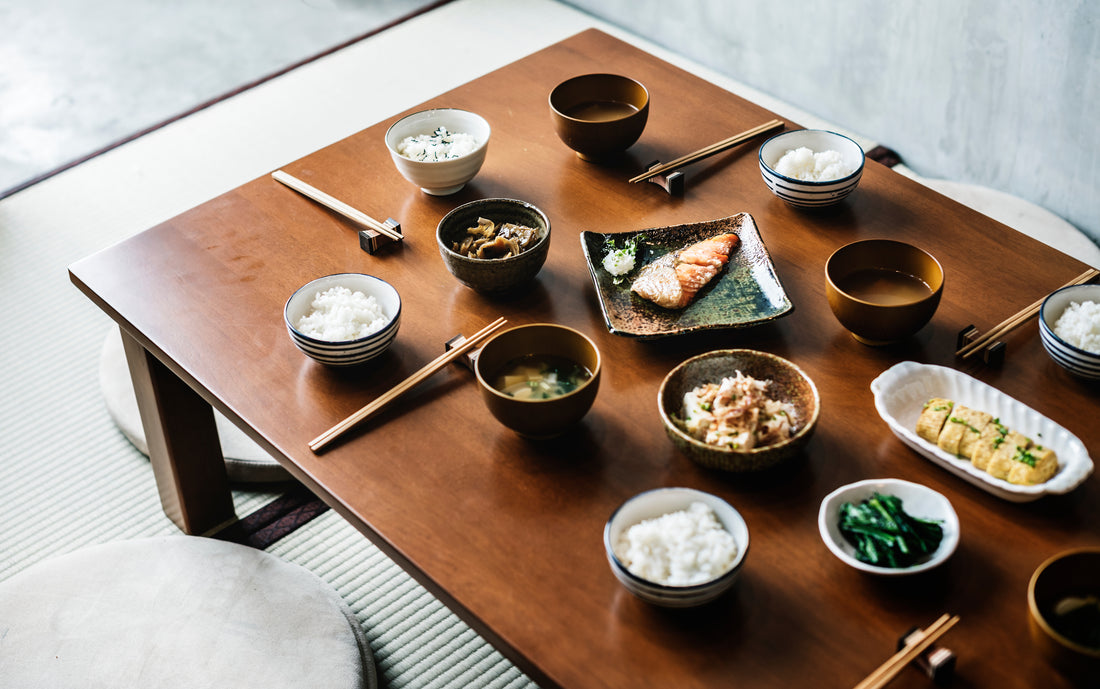The Japanese have long been known for their outstanding attention towards detail in all aspects in their lives and culture. From personal appearance, to interpersonal exchanges, to performance in the workplace, their culture has taught them to put great care and effort into everything they do. Given this great level of dedication, it comes as no surprise that Japanese dining and table setting is no different.
Japanese table setting is dependent on the formality of the dining setting and guests, as it is here in the West, though following etiquette and formal customs is more commonly seen when visiting/ hosting, and dining out there than what is typical in the U.S.
If you picture a placemat in front of you at the dinner table, the traditional Japanese composition should be as follows:
- 5 bowls (occasionally plates for larger dishes, like fish) of varying sizes, but still small enough to be held in one hand. The sizes of the bowls should generally, depending on the meal, descend from the main course (meat, fish), then white rice (which is served with almost all Japanese meals), soup (miso is a common choice), and, lastly, two small side dishes (such as tofu or vegetables.)
- Traditional Japanese tableware is usually coordinating yet eclectic, with some variation between bowl sizes, textures, colors, and shapes. The bowls compliment the foods they hold and keep the setting looking interesting and diverse.
- The rice bowl should be placed at the lower left, close to the diner. The main dish should be placed top right, farther from the diner. The side dishes should be placed in the top left, above the rice and to the left of the main dish. Lastly, the soup bowl should be in the bottom right, right of the rice and below the main dish. The chopsticks should be placed at the very bottom of the setting, closest to the diner and parallel with the table edge. A chopstick stand (箸置, hashioki) should be placed under the tips (tapered end) with the tips facing left. This setup will, of course, vary depending on the type of meal and Japanese dinner set you use, but this is the general rule of table setting.

Certain elements of Japanese cuisine have special methods and dishes for serving outside of the customs described above. Below are some other key components of Japanese dining.
Chopsticks
Chopsticks (箸, hashi) are as quintessential as rice in traditional Japanese dining. Their creation dates back to approximately 5,000 years ago in ancient China. They are the primary utensils in multiple Eastern Asian countries including China, Japan, Vietnam and Korea. In Japan, those designated for household use are tapered, reusable and washable. They come in materials such as wood, bamboo, metal, lacquered and plastic.
Chopsticks have their own set of etiquette that should be adhered to as well. As a good rule of thumb: if it would be considered impolite or poor taste to do with your fork when dining somewhere in the West, it probably applies to chopsticks too!
Sushi
The arguably most well-known Japanese dish, sushi (鮨), is a stellar example of the level of nuance and effort that goes into Japanese dining. These small, carefully crafted little rolls of rice and fish speak volumes about the chef’s level of focus and precision when creating a dish. Something so carefully made is not meant to be eaten haphazardly and without any regard for its presentation. Sushi stands or serving trays are common choices as they allow the sushi to be presented neatly and in the center of the table to be comfortably shared by all diners.

Sake
Sake (酒) is a Japanese alcoholic beverage made from fermented rice. Its flavor is described as lightly sweet and fruity, earning it the taste comparison to white wines. It can be served warm or cold depending on the flavor profile and season, similar to Western ciders.
This unique drink can be served in a few different ways, usually from a tall, thin bottle (徳利, tokkuri), into one of the multiple styles of small sake cups. The most traditional style is a small, square, wooden style known as a masu cup. This variety historically dates back to sake’s early days as a way to measure the liquid, but is now more commonly reserved for special occasions or traditional events. The modern take on the traditional Japanese sake set boasts white ceramic with non-traditional shapes and patterns- allowing it to match more effortlessly with modern interior and tableware trends.


Tea
Last but certainly not least, tea is an invaluable aspect of the Japanese diet and culture- it’s even more popular there than in the UK! There are over a dozen varieties of green tea alone that are popular in Japan.
Consuming tea is usually very casual; people enjoy it in the morning with their breakfast and offer it to their guests as a gesture of politeness, just as other nations may do with tea or coffee. What sets Japanese tea apart, though, is the formal traditional tea ceremony, known as chanoyu (茶の湯). This deeply ritualistic ceremony is still alive and well as a hobby and with some organizations that host them across Japan. You can learn more about the Japanese Tea Ceremony in our blog about it.
Traditional Japanese tea sets consist of a teapot (急須, kyusu), and cups known as yunomi (湯のみ) for informal tea drinking, or chawan (茶碗) for formal settings. These sets are renowned for their high quality and level of craftsmanship. Typically made from clay or porcelain, they should be built to withstand years’ worth of daily use.



1 comment
I would like to buy a traditional Japanese dining table to sit at with zabutons. Could you recommend a seller? I wish your site carried one. Thank you.